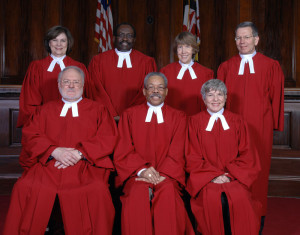 Maryland Court of Appeals has recently issued an unusual number of controversial decisions coinciding with the retirement of Chief Justice Robert Bell that will impact most Marylanders.
Maryland Court of Appeals has recently issued an unusual number of controversial decisions coinciding with the retirement of Chief Justice Robert Bell that will impact most Marylanders.
Dec 11, 2013 – Maryland Court Of Appeals Explains State Redistricting Plan Ruling – Rec
Aug 22, 2013 – Five More Convicted Murderers From Baltimore City Released – Sun
Maryland dodged a bullet on Tuesday, July 9th, when the state’s highest court decided in a 5 to 2 decision to retain Maryland’s “contributory negligence” law. That decision was just one of four important decisions recently issued that will have a real impact on Maryland, both positive and negative. Rarely has the Court rendered so many controversial decisions in such a short period, all coinciding with the retirement of Maryland’s Chief Justice since 1996, Robert Bell.
Chief Bell has long been an opponent of the contributory negligence doctrine and his retirement figured prominently in speculation that the law was about to be overturned. After all the Court only considers a small number of the 600 cases referred to it each year and the acceptance by the Court of a contributory negligence case was seen as Chief Bell’s attempt to put an end to the controversial 300+ year old law as his crowning achievement on his way out the door; however, he could not get the other justices to go along with him. Instead, as often was the case during Bell’s tenure, he found himself arguing the minority view.
The court upheld Maryland’s contributory negligence doctrine employing the same logic as did Bell’s predecessor, Chief Judge Robert C. Murphy, 30 years ago. “It is not our task to invade the province of the General Assembly and enact into law a sweeping revision,” according to the majority opinion authored by Judge Clayton Greene Jr. Maryland should be proud and the Judiciary commended for such restraint which is rare today.
The case was brought by a Howard County soccer coach, James Coleman, who was injured after swinging on a soccer goal. Under the doctrine of contributory negligence the coach can’t be compensated if he was partly to blame for his own injuries. In the alternative, most other states that use “comparative negligence” would allow some compensation but reduce total compensation by some measurement of the relative fault of each party; therefore, without the contributory negligence doctrine many more cases would be filed and the juries would have much more power to make money awards.
The Maryland General Assembly has rejected the change in doctrines many times over the years, but the fear was so great that the Court would overturn the law that supporters (including myself) sponsored a 2013 bill, HB 1156, to protect the doctrine legislatively, but the measured failed. A change in the law would have a huge impact across all areas of Maryland life. Contributory negligence is one of the few business friendly policies that allow Maryland a competitive edge over other states. The doctrine reduces frivolous litigation and holds down insurance rates and should be retained.
The Court also showed restraint in a second case, the case of Jazimen Warr, by not expanding liability in “dram shop” cases. The Court ruled that a tavern does not owe a duty to an injured person who is harmed by an intoxicated patron.
On the negative side the Court called into question “mandatory minimum” sentences in the case of Kevin Alston. In that case the Court struck down a 5 year minimum sentence given to Alston after conviction for drug distribution for possession of firearm by a felon. The Court overturned the mandatory minimum sentence and the decision could affect many past and future cases.
Still the worse decision by the Court this term was in the case of Merle Unger who killed a Hagerstown police officer in 1976. The Court found that the standard jury instructions given by Maryland courts 30 years ago were in error. On that basis, 19 convicted murderers have already been released and the final number could be as high as 200. Releasing 200 convicted murderers on a “technicality” is irresponsible and hopefully many of the 200 will be retried.












